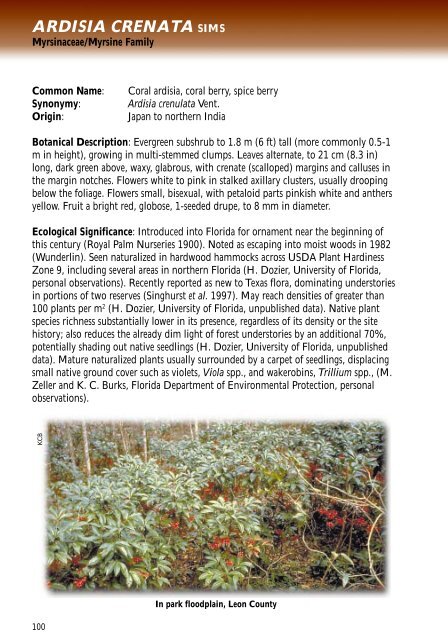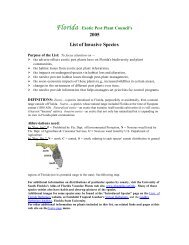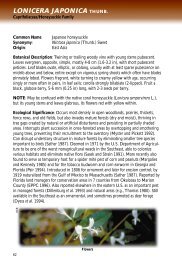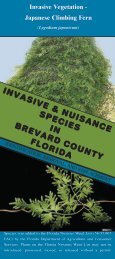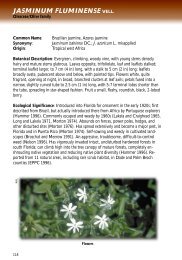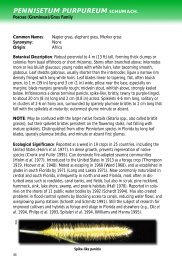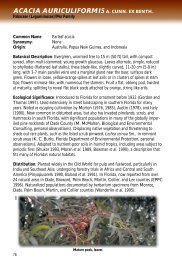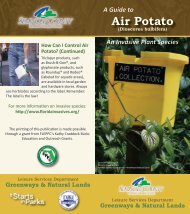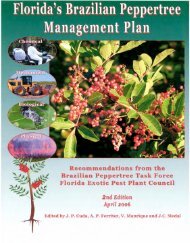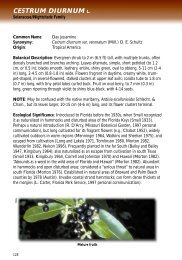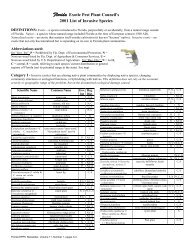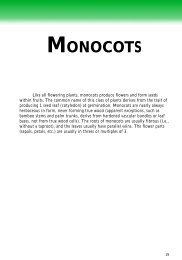DICOTS - Florida Exotic Pest Plant Council
DICOTS - Florida Exotic Pest Plant Council
DICOTS - Florida Exotic Pest Plant Council
Create successful ePaper yourself
Turn your PDF publications into a flip-book with our unique Google optimized e-Paper software.
Ardisia crenata Sims<br />
Myrsinaceae/Myrsine Family<br />
Common Name: Coral ardisia, coral berry, spice berry<br />
Synonymy: Ardisia crenulata Vent.<br />
Origin: Japan to northern India<br />
Botanical Description: Evergreen subshrub to 1.8 m (6 ft) tall (more commonly 0.5-1<br />
m in height), growing in multi-stemmed clumps. Leaves alternate, to 21 cm (8.3 in)<br />
long, dark green above, waxy, glabrous, with crenate (scalloped) margins and calluses in<br />
the margin notches. Flowers white to pink in stalked axillary clusters, usually drooping<br />
below the foliage. Flowers small, bisexual, with petaloid parts pinkish white and anthers<br />
yellow. Fruit a bright red, globose, 1-seeded drupe, to 8 mm in diameter.<br />
Ecological Significance: Introduced into <strong>Florida</strong> for ornament near the beginning of<br />
this century (Royal Palm Nurseries 1900). Noted as escaping into moist woods in 1982<br />
(Wunderlin). Seen naturalized in hardwood hammocks across USDA <strong>Plant</strong> Hardiness<br />
Zone 9, including several areas in northern <strong>Florida</strong> (H. Dozier, University of <strong>Florida</strong>,<br />
personal observations). Recently reported as new to Texas flora, dominating understories<br />
in portions of two reserves (Singhurst et al. 1997). May reach densities of greater than<br />
100 plants per m 2 (H. Dozier, University of <strong>Florida</strong>, unpublished data). Native plant<br />
species richness substantially lower in its presence, regardless of its density or the site<br />
history; also reduces the already dim light of forest understories by an additional 70%,<br />
potentially shading out native seedlings (H. Dozier, University of <strong>Florida</strong>, unpublished<br />
data). Mature naturalized plants usually surrounded by a carpet of seedlings, displacing<br />
small native ground cover such as violets, Viola spp., and wakerobins, Trillium spp., (M.<br />
Zeller and K. C. Burks, <strong>Florida</strong> Department of Environmental Protection, personal<br />
observations).<br />
KCB<br />
100<br />
In park floodplain, Leon County


